University of Essex Dissertation: Hand Hygiene Practices
VerifiedAdded on 2023/02/01
|59
|16089
|42
Thesis and Dissertation
AI Summary
This dissertation explores the critical role of hand hygiene in healthcare settings, focusing on the impact of training and awareness programs on care professionals' practices and perceptions. The research, framed within the context of hospital-acquired infections, investigates existing perceptions of hand hygiene among healthcare workers and assesses the effectiveness of awareness workshops in changing these perceptions. The study includes a literature review that examines the causes of hospital-acquired infections, the importance of hand hygiene, and the need for effective interventions. The research aims to evaluate the existing perception of hand hygiene among care professionals, to determine if an awareness workshop can change existing perceptions, and to evaluate the changes in perception or behavior after the completion of the training program. The dissertation addresses the problem of low compliance with hand hygiene protocols and emphasizes the need for strategies to improve hand hygiene within clinical settings to ensure effective infection control and patient safety, including a discussion of the five moments of hand hygiene as outlined by WHO. The study highlights the importance of hand hygiene, its impact on patient safety, and the need for improved training and implementation of hand hygiene protocols to reduce infection transmission in healthcare environments, particularly in emergency medical services.
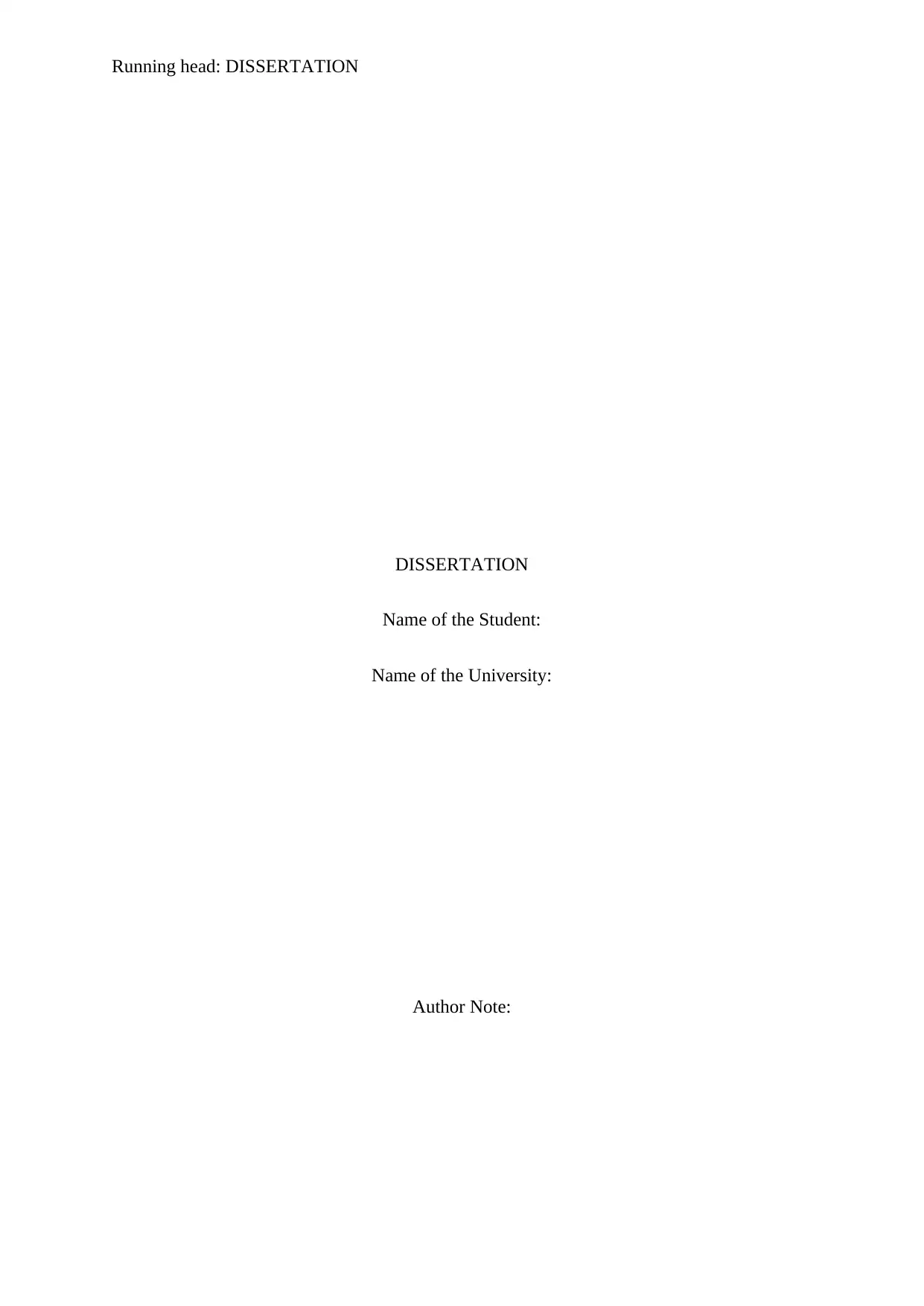
Running head: DISSERTATION
DISSERTATION
Name of the Student:
Name of the University:
Author Note:
DISSERTATION
Name of the Student:
Name of the University:
Author Note:
Paraphrase This Document
Need a fresh take? Get an instant paraphrase of this document with our AI Paraphraser
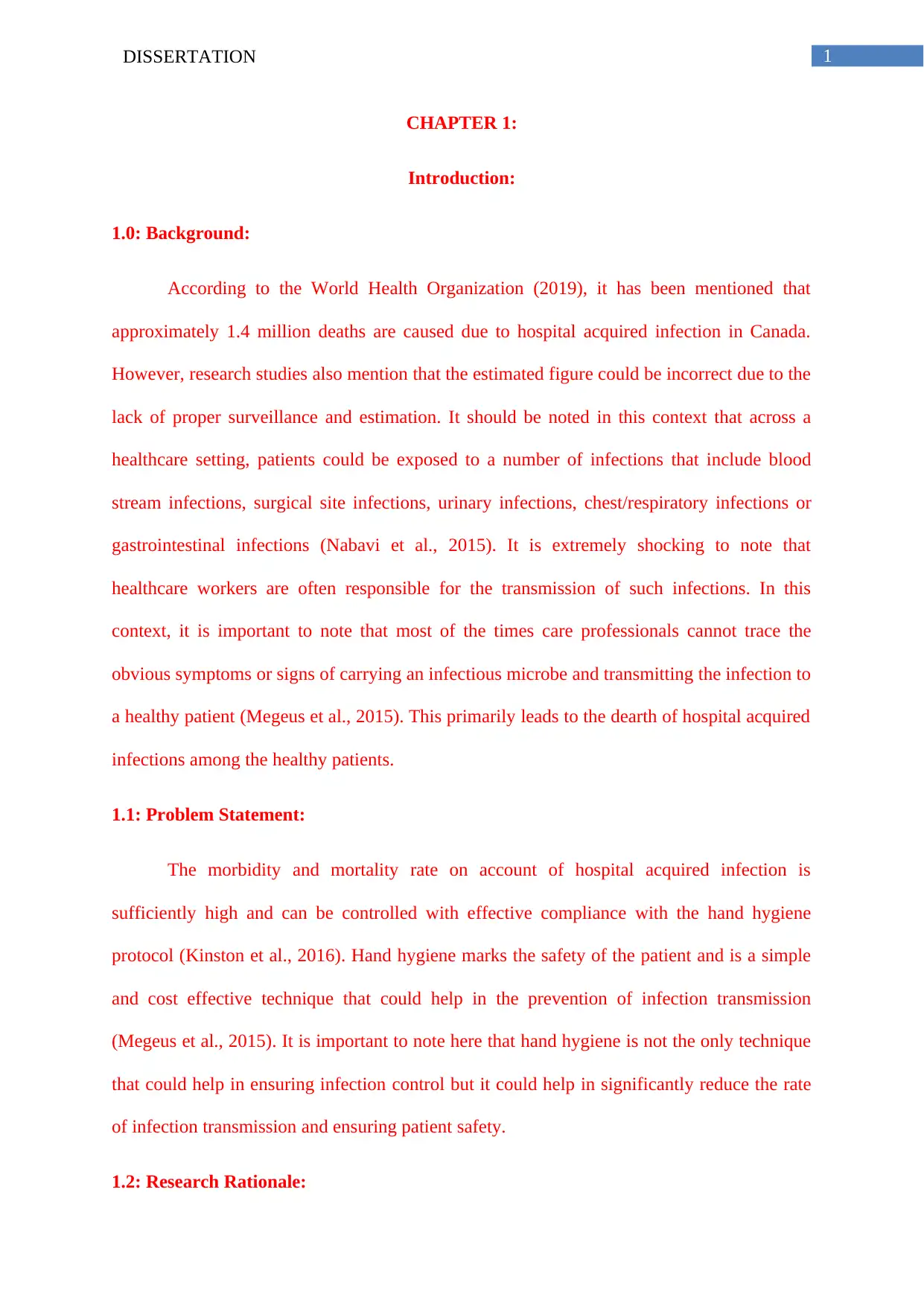
DISSERTATION 1
CHAPTER 1:
Introduction:
1.0: Background:
According to the World Health Organization (2019), it has been mentioned that
approximately 1.4 million deaths are caused due to hospital acquired infection in Canada.
However, research studies also mention that the estimated figure could be incorrect due to the
lack of proper surveillance and estimation. It should be noted in this context that across a
healthcare setting, patients could be exposed to a number of infections that include blood
stream infections, surgical site infections, urinary infections, chest/respiratory infections or
gastrointestinal infections (Nabavi et al., 2015). It is extremely shocking to note that
healthcare workers are often responsible for the transmission of such infections. In this
context, it is important to note that most of the times care professionals cannot trace the
obvious symptoms or signs of carrying an infectious microbe and transmitting the infection to
a healthy patient (Megeus et al., 2015). This primarily leads to the dearth of hospital acquired
infections among the healthy patients.
1.1: Problem Statement:
The morbidity and mortality rate on account of hospital acquired infection is
sufficiently high and can be controlled with effective compliance with the hand hygiene
protocol (Kinston et al., 2016). Hand hygiene marks the safety of the patient and is a simple
and cost effective technique that could help in the prevention of infection transmission
(Megeus et al., 2015). It is important to note here that hand hygiene is not the only technique
that could help in ensuring infection control but it could help in significantly reduce the rate
of infection transmission and ensuring patient safety.
1.2: Research Rationale:
CHAPTER 1:
Introduction:
1.0: Background:
According to the World Health Organization (2019), it has been mentioned that
approximately 1.4 million deaths are caused due to hospital acquired infection in Canada.
However, research studies also mention that the estimated figure could be incorrect due to the
lack of proper surveillance and estimation. It should be noted in this context that across a
healthcare setting, patients could be exposed to a number of infections that include blood
stream infections, surgical site infections, urinary infections, chest/respiratory infections or
gastrointestinal infections (Nabavi et al., 2015). It is extremely shocking to note that
healthcare workers are often responsible for the transmission of such infections. In this
context, it is important to note that most of the times care professionals cannot trace the
obvious symptoms or signs of carrying an infectious microbe and transmitting the infection to
a healthy patient (Megeus et al., 2015). This primarily leads to the dearth of hospital acquired
infections among the healthy patients.
1.1: Problem Statement:
The morbidity and mortality rate on account of hospital acquired infection is
sufficiently high and can be controlled with effective compliance with the hand hygiene
protocol (Kinston et al., 2016). Hand hygiene marks the safety of the patient and is a simple
and cost effective technique that could help in the prevention of infection transmission
(Megeus et al., 2015). It is important to note here that hand hygiene is not the only technique
that could help in ensuring infection control but it could help in significantly reduce the rate
of infection transmission and ensuring patient safety.
1.2: Research Rationale:
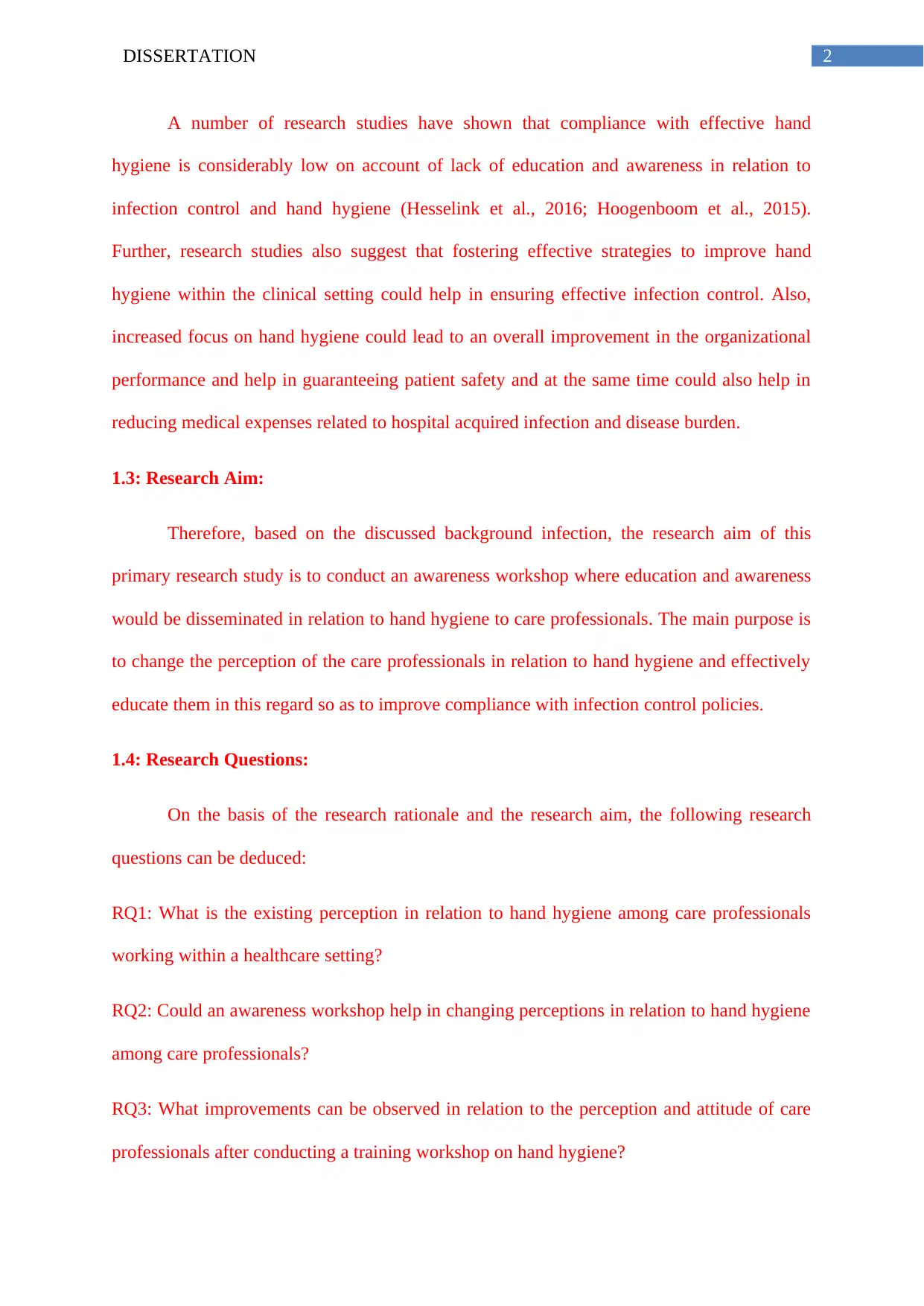
2DISSERTATION
A number of research studies have shown that compliance with effective hand
hygiene is considerably low on account of lack of education and awareness in relation to
infection control and hand hygiene (Hesselink et al., 2016; Hoogenboom et al., 2015).
Further, research studies also suggest that fostering effective strategies to improve hand
hygiene within the clinical setting could help in ensuring effective infection control. Also,
increased focus on hand hygiene could lead to an overall improvement in the organizational
performance and help in guaranteeing patient safety and at the same time could also help in
reducing medical expenses related to hospital acquired infection and disease burden.
1.3: Research Aim:
Therefore, based on the discussed background infection, the research aim of this
primary research study is to conduct an awareness workshop where education and awareness
would be disseminated in relation to hand hygiene to care professionals. The main purpose is
to change the perception of the care professionals in relation to hand hygiene and effectively
educate them in this regard so as to improve compliance with infection control policies.
1.4: Research Questions:
On the basis of the research rationale and the research aim, the following research
questions can be deduced:
RQ1: What is the existing perception in relation to hand hygiene among care professionals
working within a healthcare setting?
RQ2: Could an awareness workshop help in changing perceptions in relation to hand hygiene
among care professionals?
RQ3: What improvements can be observed in relation to the perception and attitude of care
professionals after conducting a training workshop on hand hygiene?
A number of research studies have shown that compliance with effective hand
hygiene is considerably low on account of lack of education and awareness in relation to
infection control and hand hygiene (Hesselink et al., 2016; Hoogenboom et al., 2015).
Further, research studies also suggest that fostering effective strategies to improve hand
hygiene within the clinical setting could help in ensuring effective infection control. Also,
increased focus on hand hygiene could lead to an overall improvement in the organizational
performance and help in guaranteeing patient safety and at the same time could also help in
reducing medical expenses related to hospital acquired infection and disease burden.
1.3: Research Aim:
Therefore, based on the discussed background infection, the research aim of this
primary research study is to conduct an awareness workshop where education and awareness
would be disseminated in relation to hand hygiene to care professionals. The main purpose is
to change the perception of the care professionals in relation to hand hygiene and effectively
educate them in this regard so as to improve compliance with infection control policies.
1.4: Research Questions:
On the basis of the research rationale and the research aim, the following research
questions can be deduced:
RQ1: What is the existing perception in relation to hand hygiene among care professionals
working within a healthcare setting?
RQ2: Could an awareness workshop help in changing perceptions in relation to hand hygiene
among care professionals?
RQ3: What improvements can be observed in relation to the perception and attitude of care
professionals after conducting a training workshop on hand hygiene?
⊘ This is a preview!⊘
Do you want full access?
Subscribe today to unlock all pages.

Trusted by 1+ million students worldwide
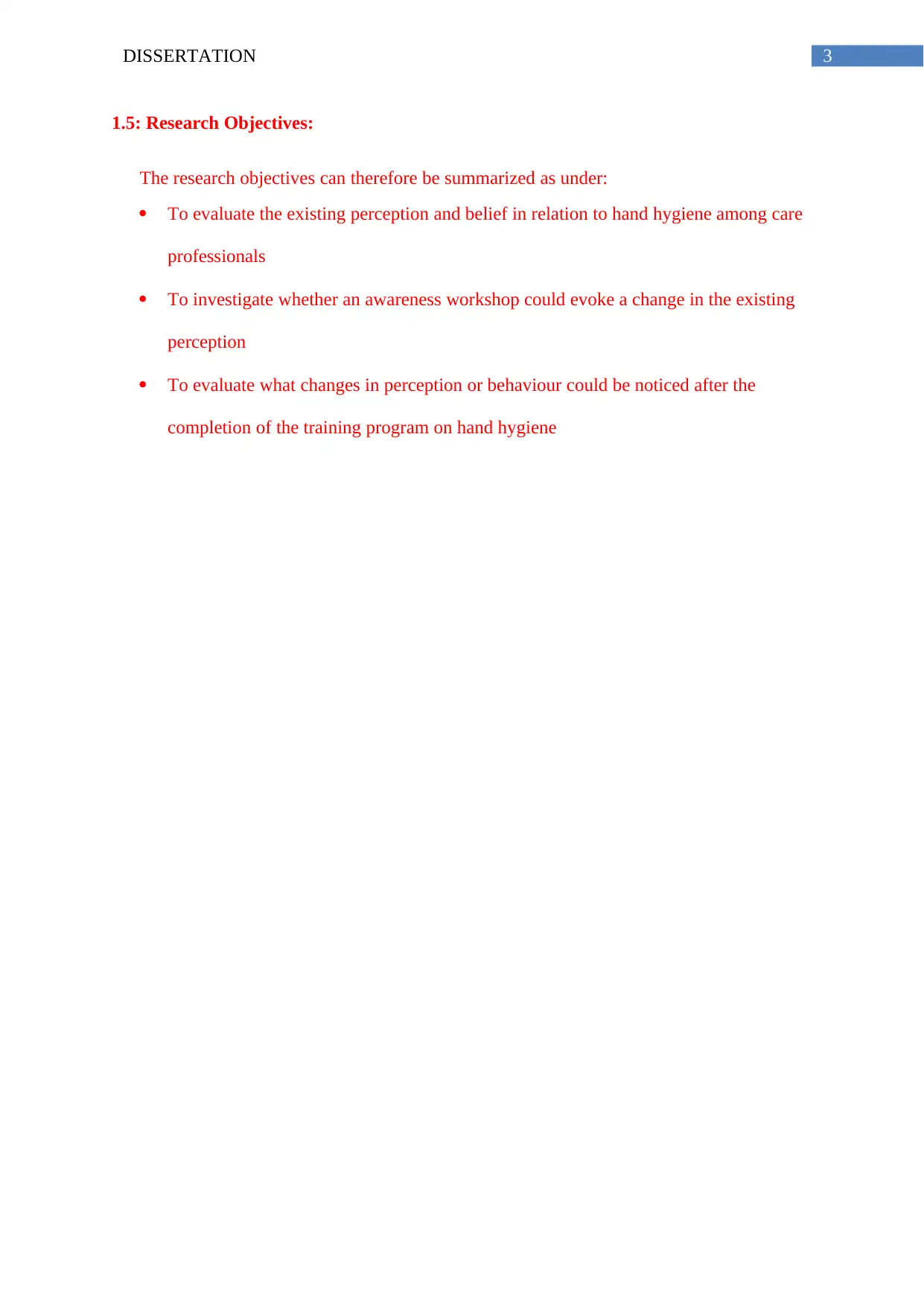
3DISSERTATION
1.5: Research Objectives:
The research objectives can therefore be summarized as under:
To evaluate the existing perception and belief in relation to hand hygiene among care
professionals
To investigate whether an awareness workshop could evoke a change in the existing
perception
To evaluate what changes in perception or behaviour could be noticed after the
completion of the training program on hand hygiene
1.5: Research Objectives:
The research objectives can therefore be summarized as under:
To evaluate the existing perception and belief in relation to hand hygiene among care
professionals
To investigate whether an awareness workshop could evoke a change in the existing
perception
To evaluate what changes in perception or behaviour could be noticed after the
completion of the training program on hand hygiene
Paraphrase This Document
Need a fresh take? Get an instant paraphrase of this document with our AI Paraphraser
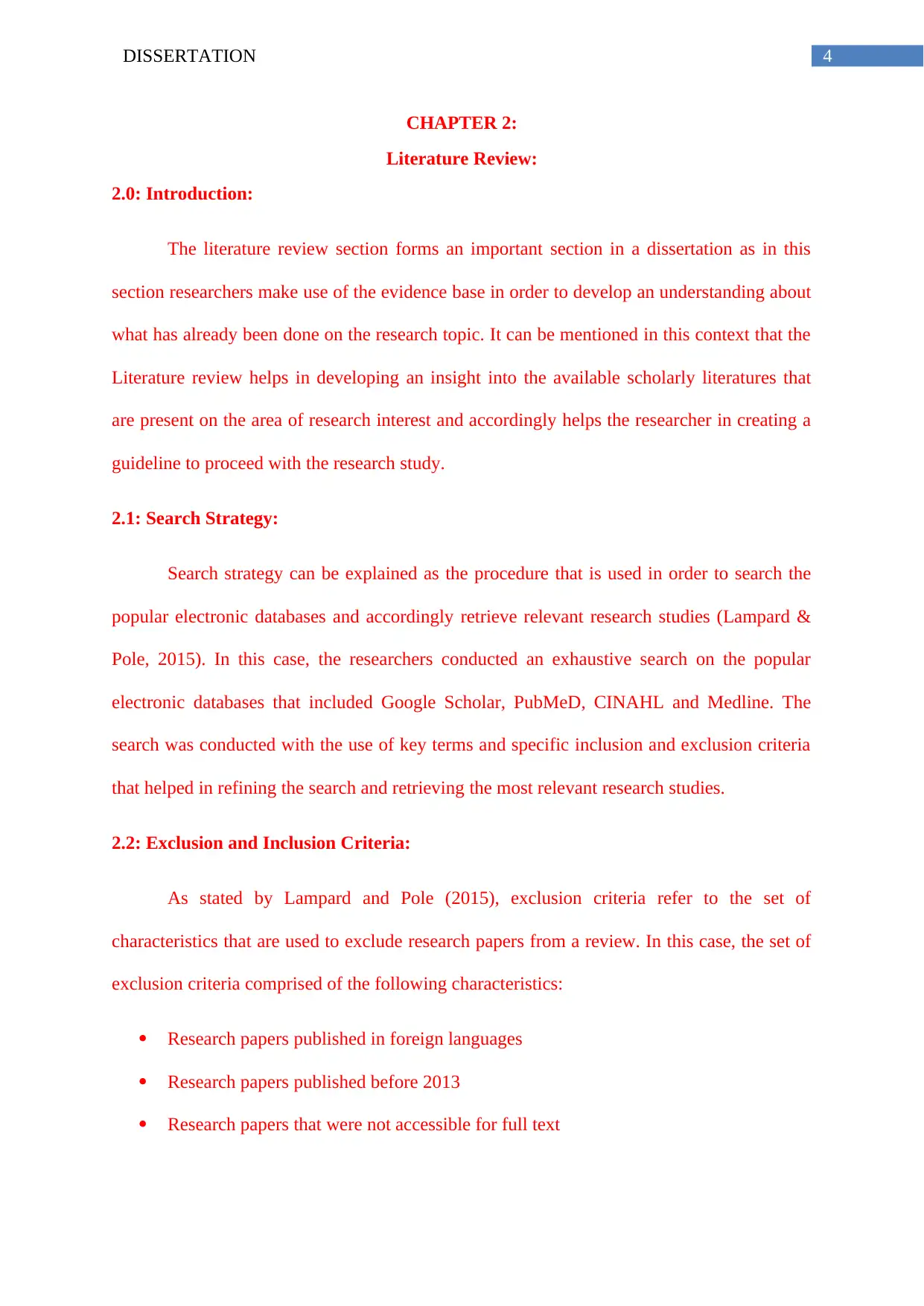
4DISSERTATION
CHAPTER 2:
Literature Review:
2.0: Introduction:
The literature review section forms an important section in a dissertation as in this
section researchers make use of the evidence base in order to develop an understanding about
what has already been done on the research topic. It can be mentioned in this context that the
Literature review helps in developing an insight into the available scholarly literatures that
are present on the area of research interest and accordingly helps the researcher in creating a
guideline to proceed with the research study.
2.1: Search Strategy:
Search strategy can be explained as the procedure that is used in order to search the
popular electronic databases and accordingly retrieve relevant research studies (Lampard &
Pole, 2015). In this case, the researchers conducted an exhaustive search on the popular
electronic databases that included Google Scholar, PubMeD, CINAHL and Medline. The
search was conducted with the use of key terms and specific inclusion and exclusion criteria
that helped in refining the search and retrieving the most relevant research studies.
2.2: Exclusion and Inclusion Criteria:
As stated by Lampard and Pole (2015), exclusion criteria refer to the set of
characteristics that are used to exclude research papers from a review. In this case, the set of
exclusion criteria comprised of the following characteristics:
Research papers published in foreign languages
Research papers published before 2013
Research papers that were not accessible for full text
CHAPTER 2:
Literature Review:
2.0: Introduction:
The literature review section forms an important section in a dissertation as in this
section researchers make use of the evidence base in order to develop an understanding about
what has already been done on the research topic. It can be mentioned in this context that the
Literature review helps in developing an insight into the available scholarly literatures that
are present on the area of research interest and accordingly helps the researcher in creating a
guideline to proceed with the research study.
2.1: Search Strategy:
Search strategy can be explained as the procedure that is used in order to search the
popular electronic databases and accordingly retrieve relevant research studies (Lampard &
Pole, 2015). In this case, the researchers conducted an exhaustive search on the popular
electronic databases that included Google Scholar, PubMeD, CINAHL and Medline. The
search was conducted with the use of key terms and specific inclusion and exclusion criteria
that helped in refining the search and retrieving the most relevant research studies.
2.2: Exclusion and Inclusion Criteria:
As stated by Lampard and Pole (2015), exclusion criteria refer to the set of
characteristics that are used to exclude research papers from a review. In this case, the set of
exclusion criteria comprised of the following characteristics:
Research papers published in foreign languages
Research papers published before 2013
Research papers that were not accessible for full text
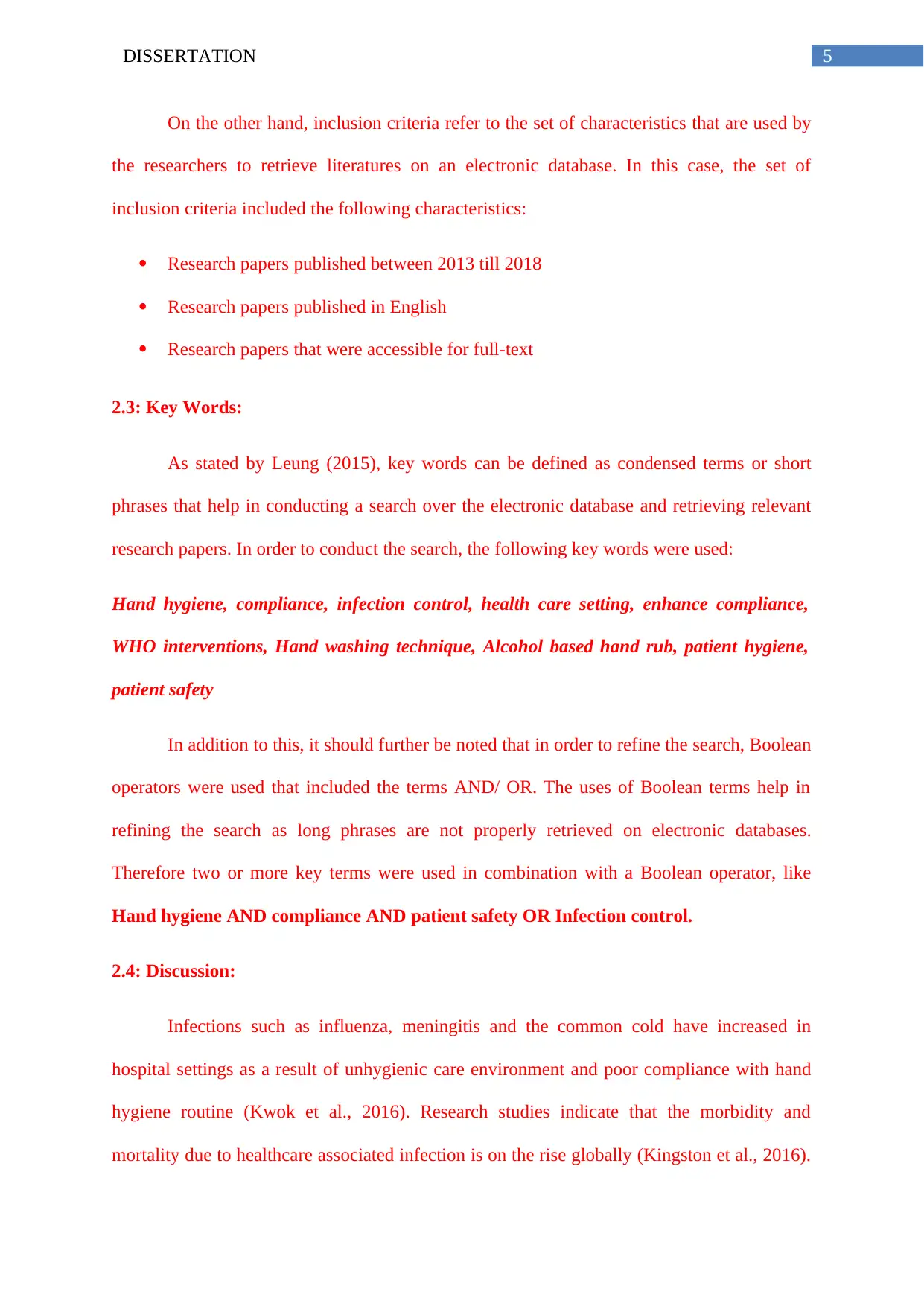
5DISSERTATION
On the other hand, inclusion criteria refer to the set of characteristics that are used by
the researchers to retrieve literatures on an electronic database. In this case, the set of
inclusion criteria included the following characteristics:
Research papers published between 2013 till 2018
Research papers published in English
Research papers that were accessible for full-text
2.3: Key Words:
As stated by Leung (2015), key words can be defined as condensed terms or short
phrases that help in conducting a search over the electronic database and retrieving relevant
research papers. In order to conduct the search, the following key words were used:
Hand hygiene, compliance, infection control, health care setting, enhance compliance,
WHO interventions, Hand washing technique, Alcohol based hand rub, patient hygiene,
patient safety
In addition to this, it should further be noted that in order to refine the search, Boolean
operators were used that included the terms AND/ OR. The uses of Boolean terms help in
refining the search as long phrases are not properly retrieved on electronic databases.
Therefore two or more key terms were used in combination with a Boolean operator, like
Hand hygiene AND compliance AND patient safety OR Infection control.
2.4: Discussion:
Infections such as influenza, meningitis and the common cold have increased in
hospital settings as a result of unhygienic care environment and poor compliance with hand
hygiene routine (Kwok et al., 2016). Research studies indicate that the morbidity and
mortality due to healthcare associated infection is on the rise globally (Kingston et al., 2016).
On the other hand, inclusion criteria refer to the set of characteristics that are used by
the researchers to retrieve literatures on an electronic database. In this case, the set of
inclusion criteria included the following characteristics:
Research papers published between 2013 till 2018
Research papers published in English
Research papers that were accessible for full-text
2.3: Key Words:
As stated by Leung (2015), key words can be defined as condensed terms or short
phrases that help in conducting a search over the electronic database and retrieving relevant
research papers. In order to conduct the search, the following key words were used:
Hand hygiene, compliance, infection control, health care setting, enhance compliance,
WHO interventions, Hand washing technique, Alcohol based hand rub, patient hygiene,
patient safety
In addition to this, it should further be noted that in order to refine the search, Boolean
operators were used that included the terms AND/ OR. The uses of Boolean terms help in
refining the search as long phrases are not properly retrieved on electronic databases.
Therefore two or more key terms were used in combination with a Boolean operator, like
Hand hygiene AND compliance AND patient safety OR Infection control.
2.4: Discussion:
Infections such as influenza, meningitis and the common cold have increased in
hospital settings as a result of unhygienic care environment and poor compliance with hand
hygiene routine (Kwok et al., 2016). Research studies indicate that the morbidity and
mortality due to healthcare associated infection is on the rise globally (Kingston et al., 2016).
⊘ This is a preview!⊘
Do you want full access?
Subscribe today to unlock all pages.

Trusted by 1+ million students worldwide
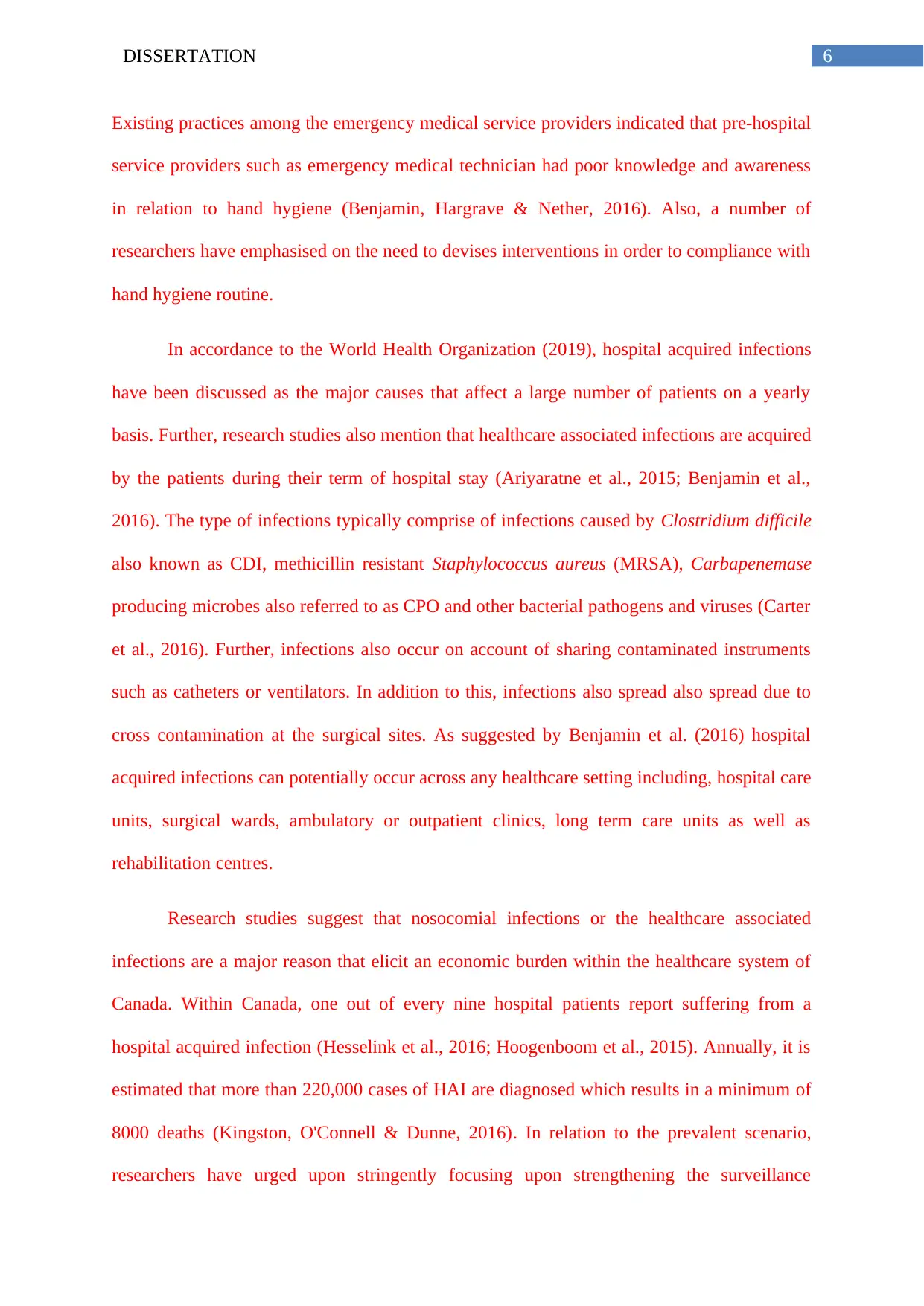
6DISSERTATION
Existing practices among the emergency medical service providers indicated that pre-hospital
service providers such as emergency medical technician had poor knowledge and awareness
in relation to hand hygiene (Benjamin, Hargrave & Nether, 2016). Also, a number of
researchers have emphasised on the need to devises interventions in order to compliance with
hand hygiene routine.
In accordance to the World Health Organization (2019), hospital acquired infections
have been discussed as the major causes that affect a large number of patients on a yearly
basis. Further, research studies also mention that healthcare associated infections are acquired
by the patients during their term of hospital stay (Ariyaratne et al., 2015; Benjamin et al.,
2016). The type of infections typically comprise of infections caused by Clostridium difficile
also known as CDI, methicillin resistant Staphylococcus aureus (MRSA), Carbapenemase
producing microbes also referred to as CPO and other bacterial pathogens and viruses (Carter
et al., 2016). Further, infections also occur on account of sharing contaminated instruments
such as catheters or ventilators. In addition to this, infections also spread also spread due to
cross contamination at the surgical sites. As suggested by Benjamin et al. (2016) hospital
acquired infections can potentially occur across any healthcare setting including, hospital care
units, surgical wards, ambulatory or outpatient clinics, long term care units as well as
rehabilitation centres.
Research studies suggest that nosocomial infections or the healthcare associated
infections are a major reason that elicit an economic burden within the healthcare system of
Canada. Within Canada, one out of every nine hospital patients report suffering from a
hospital acquired infection (Hesselink et al., 2016; Hoogenboom et al., 2015). Annually, it is
estimated that more than 220,000 cases of HAI are diagnosed which results in a minimum of
8000 deaths (Kingston, O'Connell & Dunne, 2016). In relation to the prevalent scenario,
researchers have urged upon stringently focusing upon strengthening the surveillance
Existing practices among the emergency medical service providers indicated that pre-hospital
service providers such as emergency medical technician had poor knowledge and awareness
in relation to hand hygiene (Benjamin, Hargrave & Nether, 2016). Also, a number of
researchers have emphasised on the need to devises interventions in order to compliance with
hand hygiene routine.
In accordance to the World Health Organization (2019), hospital acquired infections
have been discussed as the major causes that affect a large number of patients on a yearly
basis. Further, research studies also mention that healthcare associated infections are acquired
by the patients during their term of hospital stay (Ariyaratne et al., 2015; Benjamin et al.,
2016). The type of infections typically comprise of infections caused by Clostridium difficile
also known as CDI, methicillin resistant Staphylococcus aureus (MRSA), Carbapenemase
producing microbes also referred to as CPO and other bacterial pathogens and viruses (Carter
et al., 2016). Further, infections also occur on account of sharing contaminated instruments
such as catheters or ventilators. In addition to this, infections also spread also spread due to
cross contamination at the surgical sites. As suggested by Benjamin et al. (2016) hospital
acquired infections can potentially occur across any healthcare setting including, hospital care
units, surgical wards, ambulatory or outpatient clinics, long term care units as well as
rehabilitation centres.
Research studies suggest that nosocomial infections or the healthcare associated
infections are a major reason that elicit an economic burden within the healthcare system of
Canada. Within Canada, one out of every nine hospital patients report suffering from a
hospital acquired infection (Hesselink et al., 2016; Hoogenboom et al., 2015). Annually, it is
estimated that more than 220,000 cases of HAI are diagnosed which results in a minimum of
8000 deaths (Kingston, O'Connell & Dunne, 2016). In relation to the prevalent scenario,
researchers have urged upon stringently focusing upon strengthening the surveillance
Paraphrase This Document
Need a fresh take? Get an instant paraphrase of this document with our AI Paraphraser
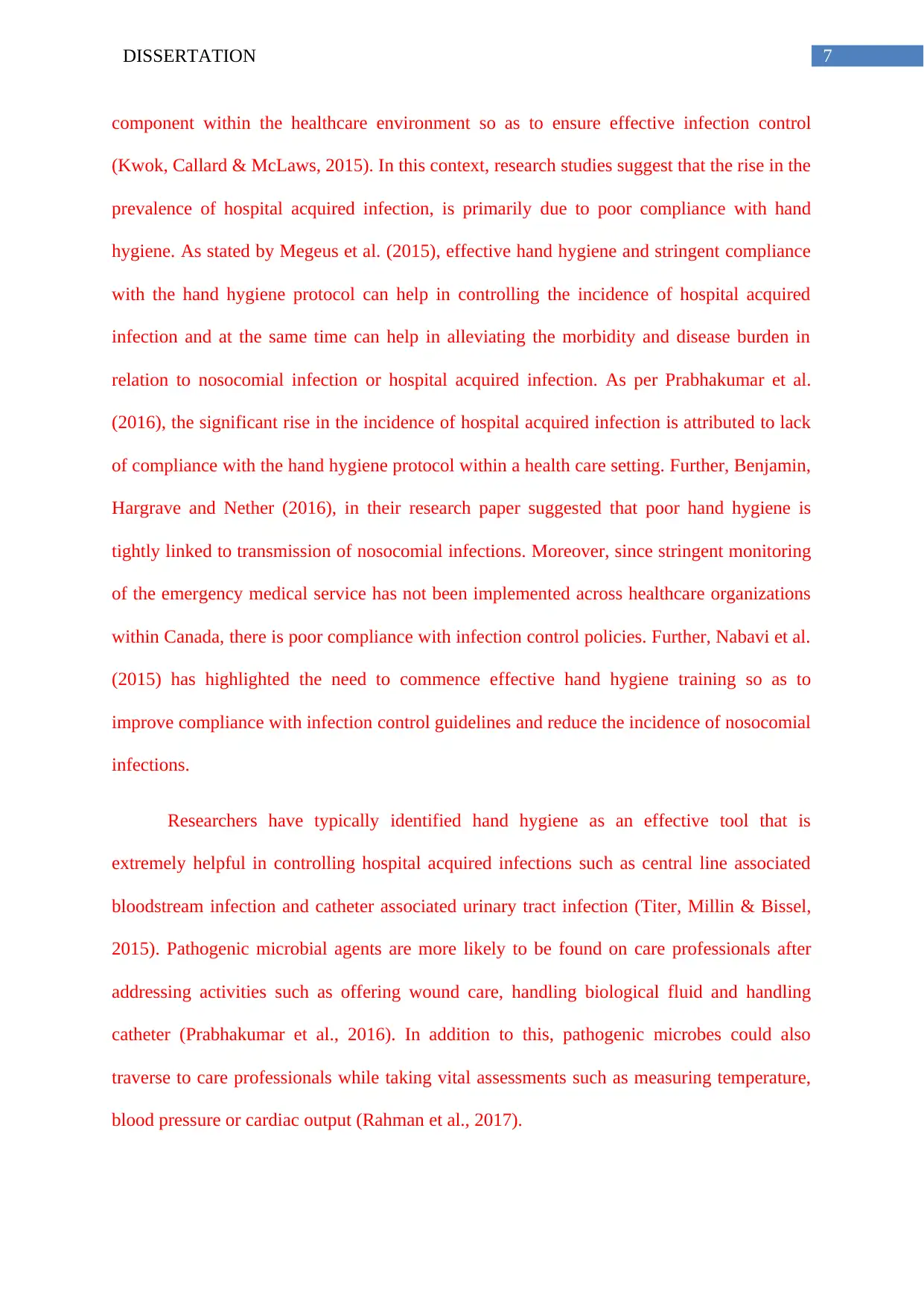
7DISSERTATION
component within the healthcare environment so as to ensure effective infection control
(Kwok, Callard & McLaws, 2015). In this context, research studies suggest that the rise in the
prevalence of hospital acquired infection, is primarily due to poor compliance with hand
hygiene. As stated by Megeus et al. (2015), effective hand hygiene and stringent compliance
with the hand hygiene protocol can help in controlling the incidence of hospital acquired
infection and at the same time can help in alleviating the morbidity and disease burden in
relation to nosocomial infection or hospital acquired infection. As per Prabhakumar et al.
(2016), the significant rise in the incidence of hospital acquired infection is attributed to lack
of compliance with the hand hygiene protocol within a health care setting. Further, Benjamin,
Hargrave and Nether (2016), in their research paper suggested that poor hand hygiene is
tightly linked to transmission of nosocomial infections. Moreover, since stringent monitoring
of the emergency medical service has not been implemented across healthcare organizations
within Canada, there is poor compliance with infection control policies. Further, Nabavi et al.
(2015) has highlighted the need to commence effective hand hygiene training so as to
improve compliance with infection control guidelines and reduce the incidence of nosocomial
infections.
Researchers have typically identified hand hygiene as an effective tool that is
extremely helpful in controlling hospital acquired infections such as central line associated
bloodstream infection and catheter associated urinary tract infection (Titer, Millin & Bissel,
2015). Pathogenic microbial agents are more likely to be found on care professionals after
addressing activities such as offering wound care, handling biological fluid and handling
catheter (Prabhakumar et al., 2016). In addition to this, pathogenic microbes could also
traverse to care professionals while taking vital assessments such as measuring temperature,
blood pressure or cardiac output (Rahman et al., 2017).
component within the healthcare environment so as to ensure effective infection control
(Kwok, Callard & McLaws, 2015). In this context, research studies suggest that the rise in the
prevalence of hospital acquired infection, is primarily due to poor compliance with hand
hygiene. As stated by Megeus et al. (2015), effective hand hygiene and stringent compliance
with the hand hygiene protocol can help in controlling the incidence of hospital acquired
infection and at the same time can help in alleviating the morbidity and disease burden in
relation to nosocomial infection or hospital acquired infection. As per Prabhakumar et al.
(2016), the significant rise in the incidence of hospital acquired infection is attributed to lack
of compliance with the hand hygiene protocol within a health care setting. Further, Benjamin,
Hargrave and Nether (2016), in their research paper suggested that poor hand hygiene is
tightly linked to transmission of nosocomial infections. Moreover, since stringent monitoring
of the emergency medical service has not been implemented across healthcare organizations
within Canada, there is poor compliance with infection control policies. Further, Nabavi et al.
(2015) has highlighted the need to commence effective hand hygiene training so as to
improve compliance with infection control guidelines and reduce the incidence of nosocomial
infections.
Researchers have typically identified hand hygiene as an effective tool that is
extremely helpful in controlling hospital acquired infections such as central line associated
bloodstream infection and catheter associated urinary tract infection (Titer, Millin & Bissel,
2015). Pathogenic microbial agents are more likely to be found on care professionals after
addressing activities such as offering wound care, handling biological fluid and handling
catheter (Prabhakumar et al., 2016). In addition to this, pathogenic microbes could also
traverse to care professionals while taking vital assessments such as measuring temperature,
blood pressure or cardiac output (Rahman et al., 2017).
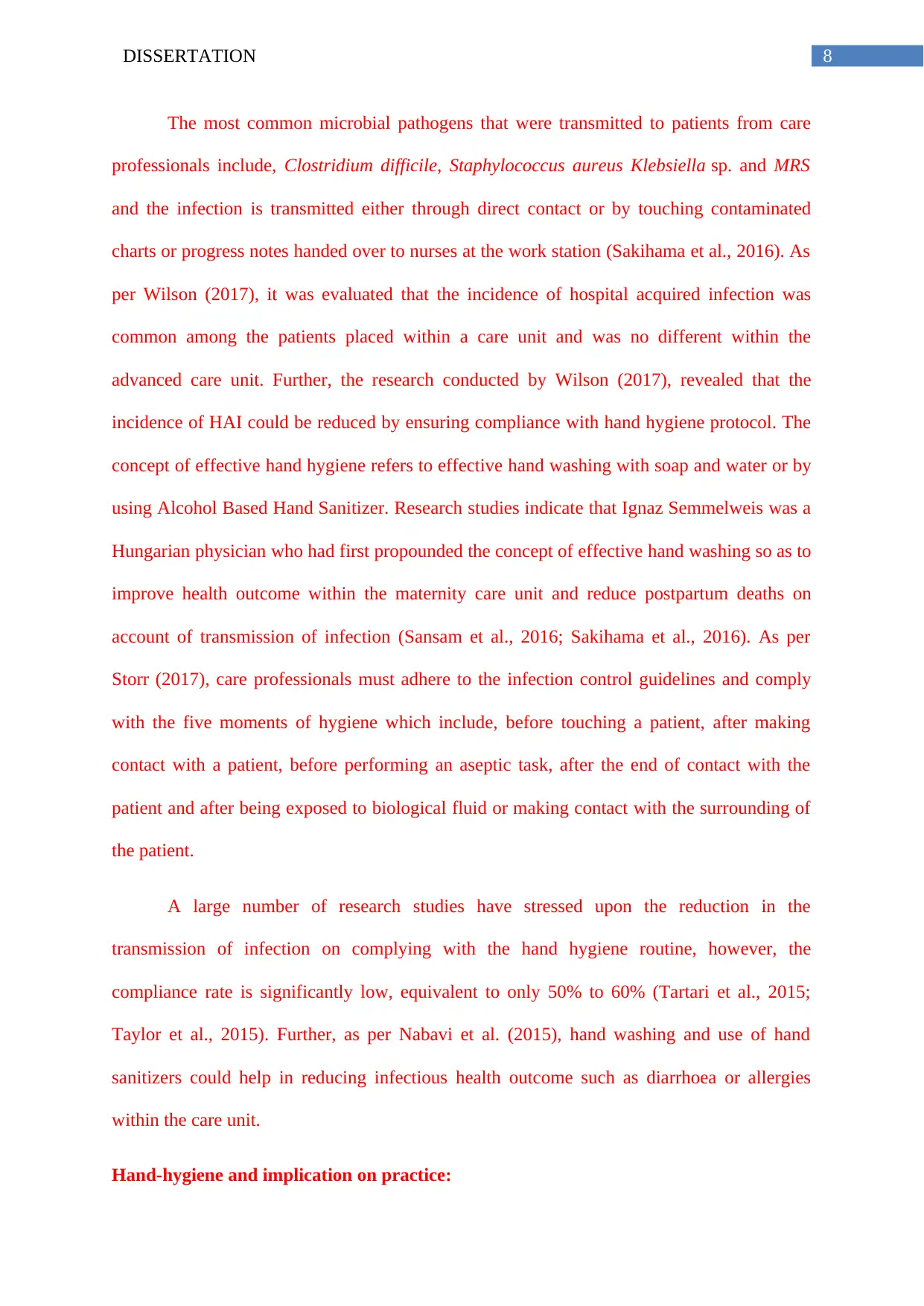
8DISSERTATION
The most common microbial pathogens that were transmitted to patients from care
professionals include, Clostridium difficile, Staphylococcus aureus Klebsiella sp. and MRS
and the infection is transmitted either through direct contact or by touching contaminated
charts or progress notes handed over to nurses at the work station (Sakihama et al., 2016). As
per Wilson (2017), it was evaluated that the incidence of hospital acquired infection was
common among the patients placed within a care unit and was no different within the
advanced care unit. Further, the research conducted by Wilson (2017), revealed that the
incidence of HAI could be reduced by ensuring compliance with hand hygiene protocol. The
concept of effective hand hygiene refers to effective hand washing with soap and water or by
using Alcohol Based Hand Sanitizer. Research studies indicate that Ignaz Semmelweis was a
Hungarian physician who had first propounded the concept of effective hand washing so as to
improve health outcome within the maternity care unit and reduce postpartum deaths on
account of transmission of infection (Sansam et al., 2016; Sakihama et al., 2016). As per
Storr (2017), care professionals must adhere to the infection control guidelines and comply
with the five moments of hygiene which include, before touching a patient, after making
contact with a patient, before performing an aseptic task, after the end of contact with the
patient and after being exposed to biological fluid or making contact with the surrounding of
the patient.
A large number of research studies have stressed upon the reduction in the
transmission of infection on complying with the hand hygiene routine, however, the
compliance rate is significantly low, equivalent to only 50% to 60% (Tartari et al., 2015;
Taylor et al., 2015). Further, as per Nabavi et al. (2015), hand washing and use of hand
sanitizers could help in reducing infectious health outcome such as diarrhoea or allergies
within the care unit.
Hand-hygiene and implication on practice:
The most common microbial pathogens that were transmitted to patients from care
professionals include, Clostridium difficile, Staphylococcus aureus Klebsiella sp. and MRS
and the infection is transmitted either through direct contact or by touching contaminated
charts or progress notes handed over to nurses at the work station (Sakihama et al., 2016). As
per Wilson (2017), it was evaluated that the incidence of hospital acquired infection was
common among the patients placed within a care unit and was no different within the
advanced care unit. Further, the research conducted by Wilson (2017), revealed that the
incidence of HAI could be reduced by ensuring compliance with hand hygiene protocol. The
concept of effective hand hygiene refers to effective hand washing with soap and water or by
using Alcohol Based Hand Sanitizer. Research studies indicate that Ignaz Semmelweis was a
Hungarian physician who had first propounded the concept of effective hand washing so as to
improve health outcome within the maternity care unit and reduce postpartum deaths on
account of transmission of infection (Sansam et al., 2016; Sakihama et al., 2016). As per
Storr (2017), care professionals must adhere to the infection control guidelines and comply
with the five moments of hygiene which include, before touching a patient, after making
contact with a patient, before performing an aseptic task, after the end of contact with the
patient and after being exposed to biological fluid or making contact with the surrounding of
the patient.
A large number of research studies have stressed upon the reduction in the
transmission of infection on complying with the hand hygiene routine, however, the
compliance rate is significantly low, equivalent to only 50% to 60% (Tartari et al., 2015;
Taylor et al., 2015). Further, as per Nabavi et al. (2015), hand washing and use of hand
sanitizers could help in reducing infectious health outcome such as diarrhoea or allergies
within the care unit.
Hand-hygiene and implication on practice:
⊘ This is a preview!⊘
Do you want full access?
Subscribe today to unlock all pages.

Trusted by 1+ million students worldwide
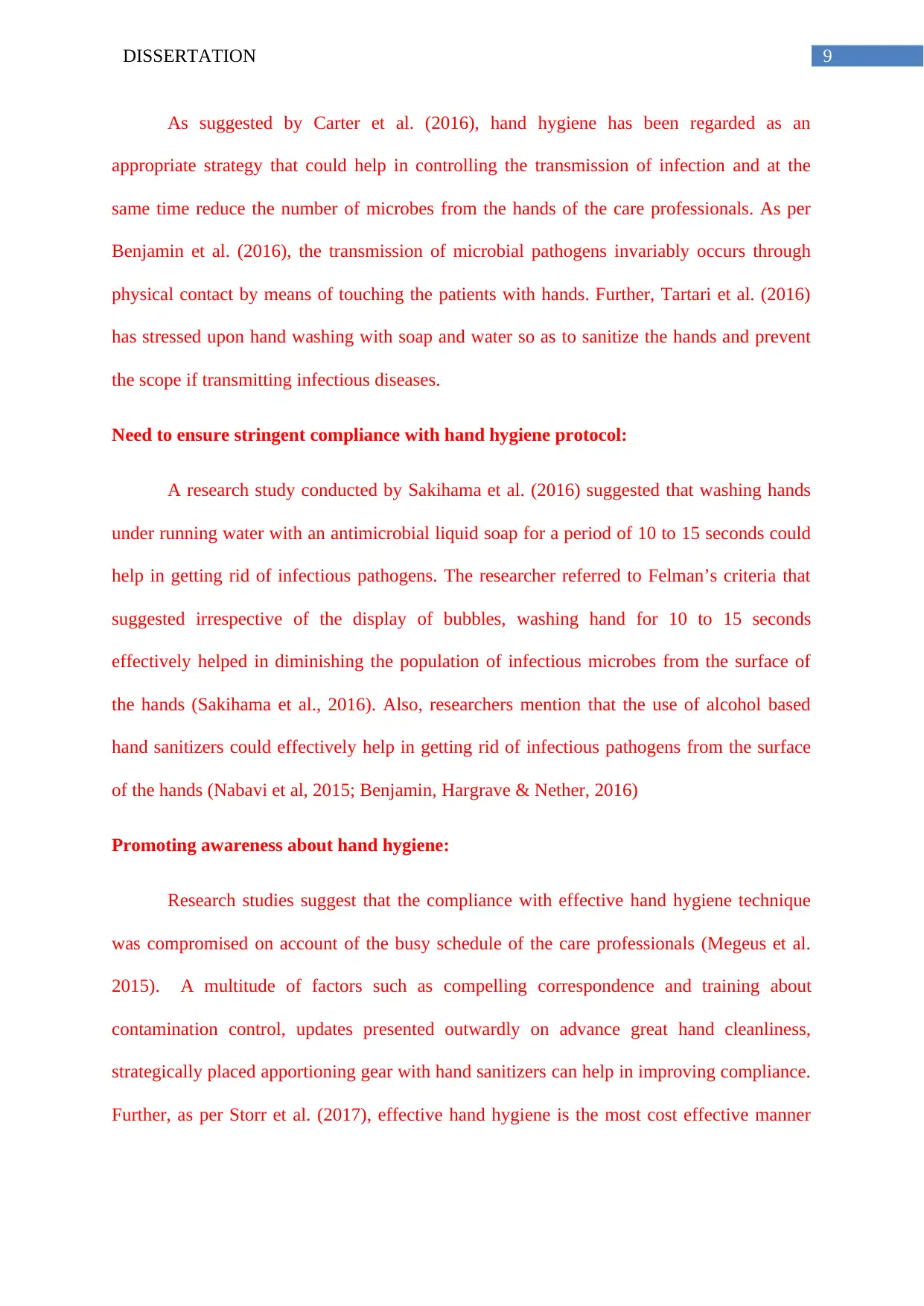
9DISSERTATION
As suggested by Carter et al. (2016), hand hygiene has been regarded as an
appropriate strategy that could help in controlling the transmission of infection and at the
same time reduce the number of microbes from the hands of the care professionals. As per
Benjamin et al. (2016), the transmission of microbial pathogens invariably occurs through
physical contact by means of touching the patients with hands. Further, Tartari et al. (2016)
has stressed upon hand washing with soap and water so as to sanitize the hands and prevent
the scope if transmitting infectious diseases.
Need to ensure stringent compliance with hand hygiene protocol:
A research study conducted by Sakihama et al. (2016) suggested that washing hands
under running water with an antimicrobial liquid soap for a period of 10 to 15 seconds could
help in getting rid of infectious pathogens. The researcher referred to Felman’s criteria that
suggested irrespective of the display of bubbles, washing hand for 10 to 15 seconds
effectively helped in diminishing the population of infectious microbes from the surface of
the hands (Sakihama et al., 2016). Also, researchers mention that the use of alcohol based
hand sanitizers could effectively help in getting rid of infectious pathogens from the surface
of the hands (Nabavi et al, 2015; Benjamin, Hargrave & Nether, 2016)
Promoting awareness about hand hygiene:
Research studies suggest that the compliance with effective hand hygiene technique
was compromised on account of the busy schedule of the care professionals (Megeus et al.
2015). A multitude of factors such as compelling correspondence and training about
contamination control, updates presented outwardly on advance great hand cleanliness,
strategically placed apportioning gear with hand sanitizers can help in improving compliance.
Further, as per Storr et al. (2017), effective hand hygiene is the most cost effective manner
As suggested by Carter et al. (2016), hand hygiene has been regarded as an
appropriate strategy that could help in controlling the transmission of infection and at the
same time reduce the number of microbes from the hands of the care professionals. As per
Benjamin et al. (2016), the transmission of microbial pathogens invariably occurs through
physical contact by means of touching the patients with hands. Further, Tartari et al. (2016)
has stressed upon hand washing with soap and water so as to sanitize the hands and prevent
the scope if transmitting infectious diseases.
Need to ensure stringent compliance with hand hygiene protocol:
A research study conducted by Sakihama et al. (2016) suggested that washing hands
under running water with an antimicrobial liquid soap for a period of 10 to 15 seconds could
help in getting rid of infectious pathogens. The researcher referred to Felman’s criteria that
suggested irrespective of the display of bubbles, washing hand for 10 to 15 seconds
effectively helped in diminishing the population of infectious microbes from the surface of
the hands (Sakihama et al., 2016). Also, researchers mention that the use of alcohol based
hand sanitizers could effectively help in getting rid of infectious pathogens from the surface
of the hands (Nabavi et al, 2015; Benjamin, Hargrave & Nether, 2016)
Promoting awareness about hand hygiene:
Research studies suggest that the compliance with effective hand hygiene technique
was compromised on account of the busy schedule of the care professionals (Megeus et al.
2015). A multitude of factors such as compelling correspondence and training about
contamination control, updates presented outwardly on advance great hand cleanliness,
strategically placed apportioning gear with hand sanitizers can help in improving compliance.
Further, as per Storr et al. (2017), effective hand hygiene is the most cost effective manner
Paraphrase This Document
Need a fresh take? Get an instant paraphrase of this document with our AI Paraphraser
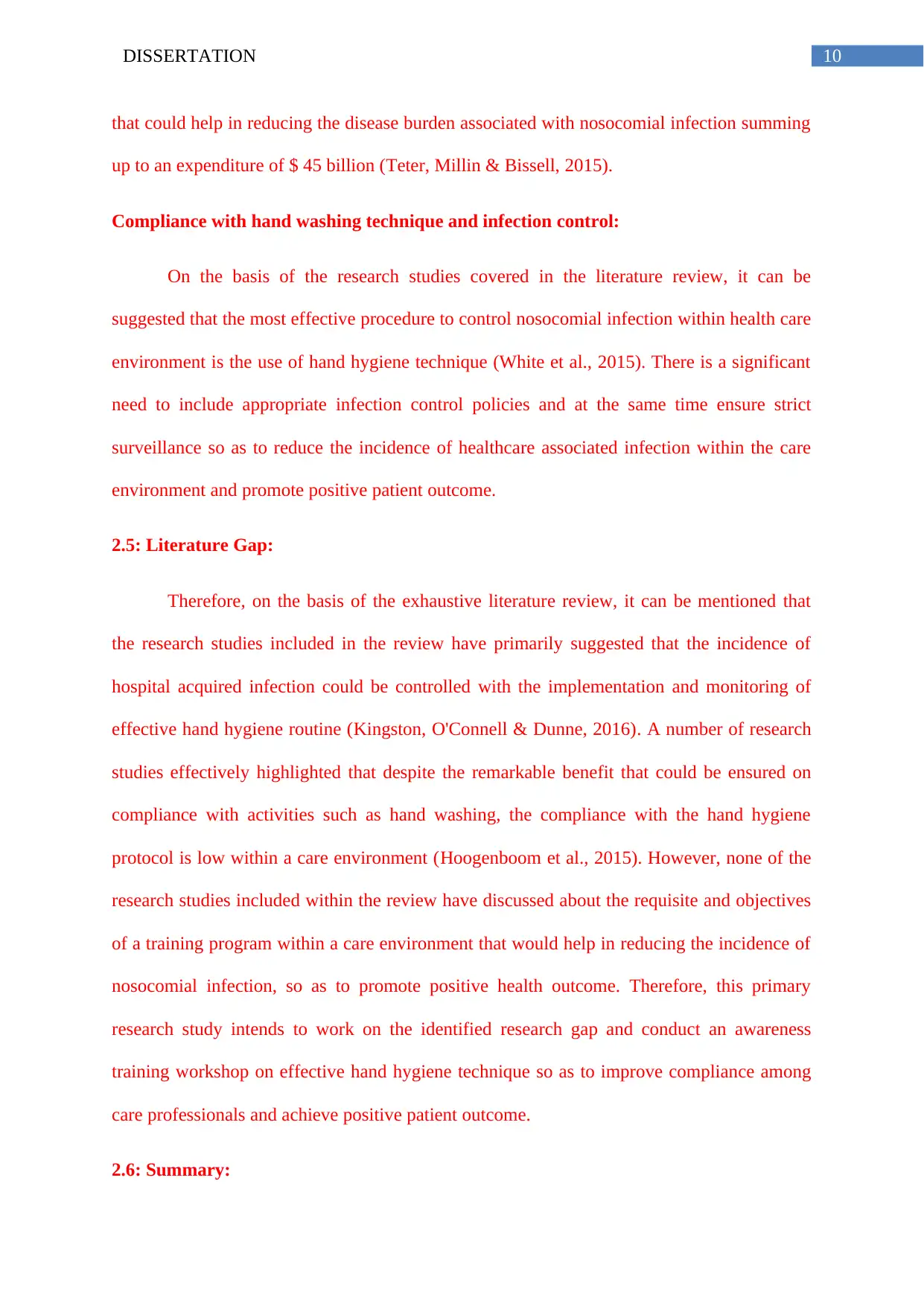
10DISSERTATION
that could help in reducing the disease burden associated with nosocomial infection summing
up to an expenditure of $ 45 billion (Teter, Millin & Bissell, 2015).
Compliance with hand washing technique and infection control:
On the basis of the research studies covered in the literature review, it can be
suggested that the most effective procedure to control nosocomial infection within health care
environment is the use of hand hygiene technique (White et al., 2015). There is a significant
need to include appropriate infection control policies and at the same time ensure strict
surveillance so as to reduce the incidence of healthcare associated infection within the care
environment and promote positive patient outcome.
2.5: Literature Gap:
Therefore, on the basis of the exhaustive literature review, it can be mentioned that
the research studies included in the review have primarily suggested that the incidence of
hospital acquired infection could be controlled with the implementation and monitoring of
effective hand hygiene routine (Kingston, O'Connell & Dunne, 2016). A number of research
studies effectively highlighted that despite the remarkable benefit that could be ensured on
compliance with activities such as hand washing, the compliance with the hand hygiene
protocol is low within a care environment (Hoogenboom et al., 2015). However, none of the
research studies included within the review have discussed about the requisite and objectives
of a training program within a care environment that would help in reducing the incidence of
nosocomial infection, so as to promote positive health outcome. Therefore, this primary
research study intends to work on the identified research gap and conduct an awareness
training workshop on effective hand hygiene technique so as to improve compliance among
care professionals and achieve positive patient outcome.
2.6: Summary:
that could help in reducing the disease burden associated with nosocomial infection summing
up to an expenditure of $ 45 billion (Teter, Millin & Bissell, 2015).
Compliance with hand washing technique and infection control:
On the basis of the research studies covered in the literature review, it can be
suggested that the most effective procedure to control nosocomial infection within health care
environment is the use of hand hygiene technique (White et al., 2015). There is a significant
need to include appropriate infection control policies and at the same time ensure strict
surveillance so as to reduce the incidence of healthcare associated infection within the care
environment and promote positive patient outcome.
2.5: Literature Gap:
Therefore, on the basis of the exhaustive literature review, it can be mentioned that
the research studies included in the review have primarily suggested that the incidence of
hospital acquired infection could be controlled with the implementation and monitoring of
effective hand hygiene routine (Kingston, O'Connell & Dunne, 2016). A number of research
studies effectively highlighted that despite the remarkable benefit that could be ensured on
compliance with activities such as hand washing, the compliance with the hand hygiene
protocol is low within a care environment (Hoogenboom et al., 2015). However, none of the
research studies included within the review have discussed about the requisite and objectives
of a training program within a care environment that would help in reducing the incidence of
nosocomial infection, so as to promote positive health outcome. Therefore, this primary
research study intends to work on the identified research gap and conduct an awareness
training workshop on effective hand hygiene technique so as to improve compliance among
care professionals and achieve positive patient outcome.
2.6: Summary:
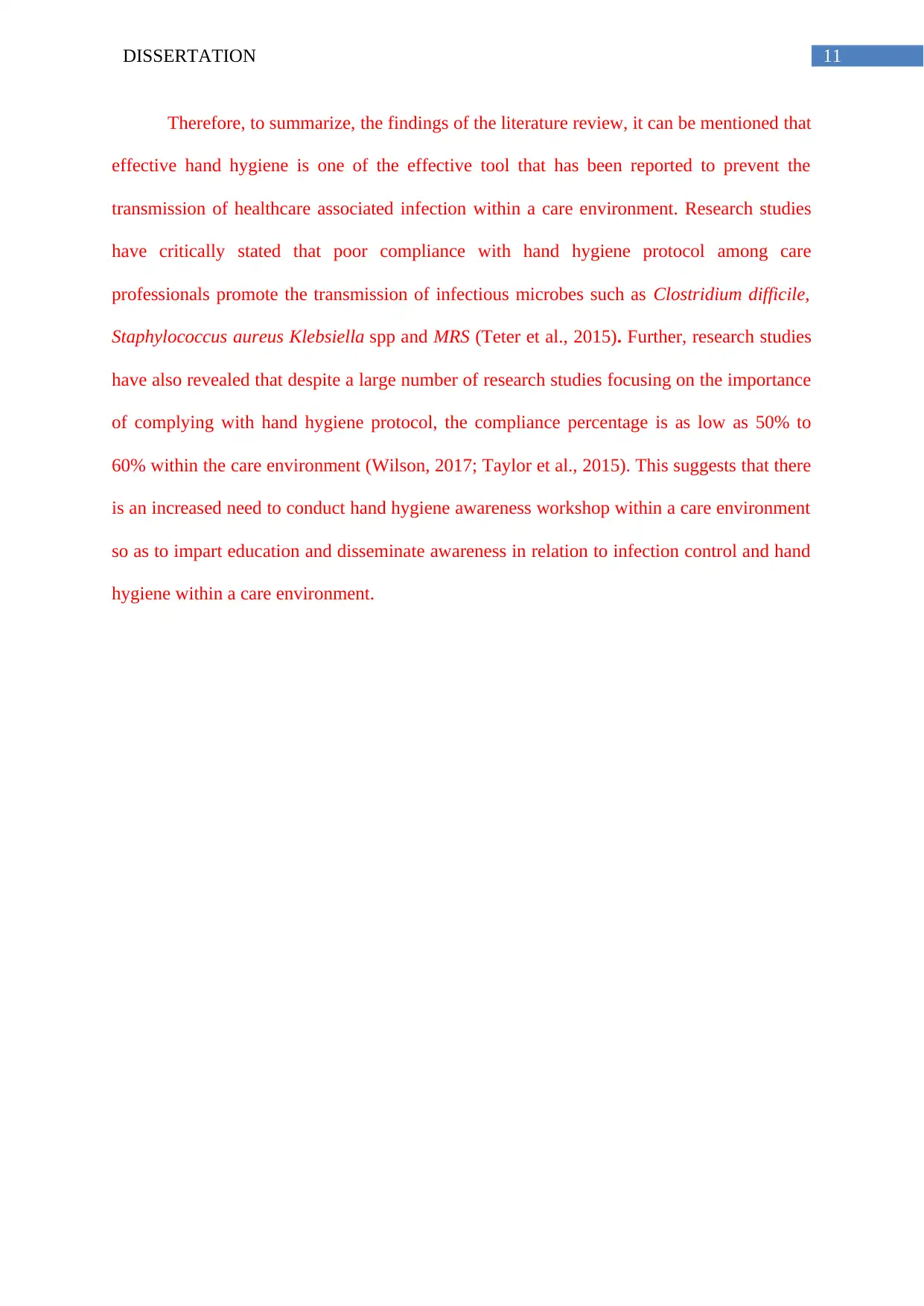
11DISSERTATION
Therefore, to summarize, the findings of the literature review, it can be mentioned that
effective hand hygiene is one of the effective tool that has been reported to prevent the
transmission of healthcare associated infection within a care environment. Research studies
have critically stated that poor compliance with hand hygiene protocol among care
professionals promote the transmission of infectious microbes such as Clostridium difficile,
Staphylococcus aureus Klebsiella spp and MRS (Teter et al., 2015). Further, research studies
have also revealed that despite a large number of research studies focusing on the importance
of complying with hand hygiene protocol, the compliance percentage is as low as 50% to
60% within the care environment (Wilson, 2017; Taylor et al., 2015). This suggests that there
is an increased need to conduct hand hygiene awareness workshop within a care environment
so as to impart education and disseminate awareness in relation to infection control and hand
hygiene within a care environment.
Therefore, to summarize, the findings of the literature review, it can be mentioned that
effective hand hygiene is one of the effective tool that has been reported to prevent the
transmission of healthcare associated infection within a care environment. Research studies
have critically stated that poor compliance with hand hygiene protocol among care
professionals promote the transmission of infectious microbes such as Clostridium difficile,
Staphylococcus aureus Klebsiella spp and MRS (Teter et al., 2015). Further, research studies
have also revealed that despite a large number of research studies focusing on the importance
of complying with hand hygiene protocol, the compliance percentage is as low as 50% to
60% within the care environment (Wilson, 2017; Taylor et al., 2015). This suggests that there
is an increased need to conduct hand hygiene awareness workshop within a care environment
so as to impart education and disseminate awareness in relation to infection control and hand
hygiene within a care environment.
⊘ This is a preview!⊘
Do you want full access?
Subscribe today to unlock all pages.

Trusted by 1+ million students worldwide
1 out of 59
Related Documents
Your All-in-One AI-Powered Toolkit for Academic Success.
+13062052269
info@desklib.com
Available 24*7 on WhatsApp / Email
![[object Object]](/_next/static/media/star-bottom.7253800d.svg)
Unlock your academic potential
Copyright © 2020–2025 A2Z Services. All Rights Reserved. Developed and managed by ZUCOL.





